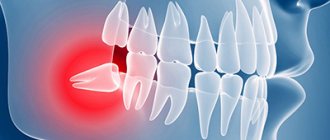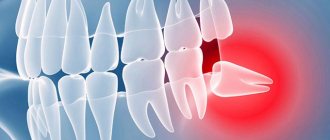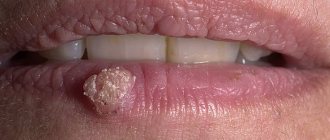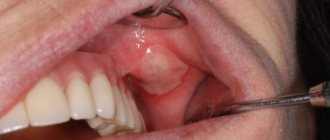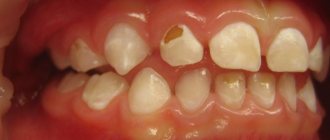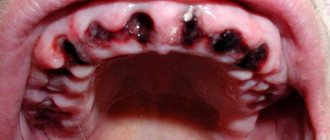Recurrent aphthous stomatitis
Recurrent aphthous stomatitis is a chronic pathology characterized by inflammation of the oral mucosa. Its main symptom is a rash of aphthae or ulcers, which are noticeably painful. Aphthae usually appear periodically in the following areas:
- Language;
- Cheeks;
- Hard and soft palate;
- Mucous membrane of the lips.
If ulcers are periodically injured, they can develop into full-fledged, difficult-to-heal wounds, in place of which noticeable scars remain. The normal healing time for aphthae is no more than a week from the moment of its appearance.
The prerequisites for the occurrence of aphthous stomatitis are as follows:
- Chronic colitis;
- Diseases of the nervous system;
- Chronic stress;
- Injury to the mucous membrane;
- Hormonal imbalance during menstruation.
With a normally functioning immune system, ulcers heal on their own in one, or in extreme cases, two weeks. If healing does not occur, you must visit a doctor to prescribe the correct treatment. As a rule, the basis of therapy is taking vitamin C, which has a positive effect on the immune system.
Is a diet necessary when treating a trophic ulcer?
What should be avoided if there is a trophic ulcer? Photos of complications will help you control yourself when dieting. Diet for trophic ulcers excludes salty foods and spices. It is necessary to saturate the body with nutrients, vitamins and Omega-3 acids. Vegetables (carrots, tomatoes, cabbage), fruits, nuts, milk, cheeses, vegetable and butter, and fish are especially useful. You should eat small portions to avoid a sharp increase in blood sugar. A radical change in diet is not required; a small adjustment will have a beneficial effect on the healing process.
Herpetiform stomatitis
Herpertiform stomatitis is characterized by the appearance of numerous ulcers on the oral mucosa, which in appearance resemble ordinary herpes. Girls under 30 are at risk - they are the ones who suffer from pathology more than others. Locations of the disease:
- Underside of tongue;
- Floor of the oral cavity.
Ulcers heal in no more than 10 days from the moment they appear, leaving no scars. Treatment, as in the case of the previous type of stomatitis, is based on the use of vitamin C. The dosage and regimen of medications is prescribed by the attending physician.
Trophic ulcer - treatment without surgery
If the cause of the ulcer is not venous pathology, then conservative measures are sufficient. A portable laser device is a great help in home treatment of the initial stages of ulcerative skin lesions up to 50 cm2 in size. A laser injected into a vein helps reduce blood viscosity, significantly reduces the risk of blood clots, and increases blood flow in problem areas. In addition, the laser beam effectively reduces pain and trophic ulcers. Laser treatment (reviews below) in combination with conservative treatment allows you to avoid surgical intervention.
Laser therapy is carried out in courses of 10-15 procedures. With the correct individual selection of treatment parameters, this treatment method does not cause complications, patients note good tolerability of the procedures, and the trophic ulcer is quickly eliminated. Laser treatment, the price of which is not too high, is very popular.
Recurrent necrotizing peryadenitis
Recurrent necrotizing peryadenitis is also called Setton's aphthae. Its symptoms are:
- Seals appear in the submucosa of the oral cavity;
- Instead of compactions, ulcers with raised edges develop over time;
- The ulcers become inflamed, causing blood and lymphatic discharge.
Places where such afts accumulate are the upper and lower lips, cheeks and sides of the tongue. The pathology is characterized by extremely severe pain. Patients find it so difficult to eat that many give up eating completely. Difficulties also arise during conversation. The healing process of aphthae lasts a long time - sometimes up to several months, and the pathology itself persists for up to several years.
Trophic ulcer - symptoms
Trophic ulcers do not form spontaneously. Initially, swelling appears, accompanied by severe itching. The skin becomes thinner. Pigmentation or cyanosis appears.
Multiple trophic ulcers on the leg
The appearance of a trophic ulcer is often accompanied by chills and night cramps of the calf muscles. Due to stagnation in the lymphatic vessels, droplets of liquid begin to appear on the glassy surface of the skin. Next, the foci of exfoliated epidermis merge, and an ulcer with ragged, compacted edges is formed, causing severe pain at the slightest touch. As a rule, the ulcer surface is quickly colonized by bacteria, and the bleeding ulcer begins to fester.
Afty Bednar
Bednar's aphthae is the appearance of small wounds on the oral mucosa. The pathology manifests itself exclusively in children due to poor hygiene or accidental injury.
The location of the ulcers is the palate. They have a slightly yellowish coating and heal quite quickly - up to 5 days. For the pathology to go away, it is enough to normalize oral hygiene.
The gums become inflamed due to insufficient oral hygiene and lack of regular visits to the dentist. The result is an excessive accumulation of plaque on the teeth and pathogenic microorganisms. Pathogenic microorganisms trigger a process in which their own toxins and inflammatory mediators are generated. Treatment of diseases of the mucous membranes and gums with the Vector device
Traumatic mouth ulcers
The name of traumatic ulcers speaks for itself. This is the appearance of wounds in the oral cavity due to injury to the mucous membrane. The causes of injury may be:
- Bite of the mucous membrane;
- Accidental contact with a toothbrush;
- Inaccurate dental treatment.
One of the types of traumatic ulcers are prosthetic ulcers - wounds formed due to incorrect sizes of removable dentures. They are localized precisely under the dentures.
Healing of traumatic ulcers lasts 1-2 weeks. As a rule, this is a one-time pathology that goes away on its own without additional treatment. Such aphthae are painless and small in size.
If a complication of the disease nevertheless begins, it is necessary to visit a doctor so that he can prescribe anti-inflammatory and antibacterial medications to completely eliminate the pathology.
Causes of the disease
The main reason for the development of this pathology is the penetration of infection into the body due to constant microtrauma. The most easily infected wounds are those caused by carious teeth.
The second most common reason is dentures. Although many of them fit quite tightly, some put too much pressure on the gums. As a result, the process of self-cleaning of teeth is hampered and the natural balance of microflora is disrupted.
Crowns and dentures irritate the lining of the gums and can create small wounds that are a gateway to infection.
Additional factors in the development of ulcers are bad habits, stress, insufficient and unhealthy nutrition, as well as seasonal vitamin deficiency.
Quite often, ulcers develop in patients with malocclusion due to uneven pressure exerted on the gums.
Tuberculosis of the oral mucosa
Tuberculosis of the oral mucosa is a complication of standard pulmonary tuberculosis. The cause of the pathology is the penetration of bacteria into the oral cavity through damaged soft tissues. Localization of ulcers occurs in the following places:
- Cheeks;
- Language;
- Floor of the oral cavity.
At the affected sites, standard tuberculous tubercles first form, and then ulcers appear in their place. They do not heal and gradually increase in size. Aphthae are shallow, but very loose with slight bleeding. Their edges are soft, but despite this, the ulcers are noticeably painful.
Usually, along with the appearance of tuberculous ulcers, the patient feels a general deterioration of his condition, which manifests itself in the following symptoms:
- Loss of appetite and weight;
- The appearance of a white coating on the tongue;
- Sweating;
- High body temperature.
Treatment of such a pathology involves staying in a special closed dispensary. As a rule, during the period of weakening of the symptoms of the disease, sanitation of the oral cavity is carried out, as well as treatment with anti-inflammatory and antibacterial drugs.
Syphilis
Syphilis is an infectious pathology caused by Treponema pallidum. Mouth ulcers are a typical symptom of syphilis that appears throughout the entire period of the disease. Moreover, the ulcers themselves undergo a certain development process:
- The ulcers are round in shape and have dense edges. They are painless and have a white coating.
- Over time, the ulcers begin to bleed slightly.
- After about 1-3 months, the ulcers heal, and in their place strong scars form, around which dense bluish edges are concentrated.
After defeating syphilis, dense scars still remain in the oral cavity. They are the most eloquent sign of a recent illness.
Treatment of syphilis is carried out in a closed venereology clinic. During remission, the oral cavity is treated with anti-inflammatory and antibacterial drugs.
Acute necrotizing gingivostomatitis
Acute necrotizing gingivostomatitis is a viral infectious pathology in which ulcers form on the surface of the entire oral mucosa, including the tonsils. The prerequisites for this disease are:
- Deterioration of the immune system;
- Injury to the oral mucosa;
- Lack of vitamins and minerals in the body;
- Chronic severe fatigue;
- Sudden hypothermia;
- Complication of ordinary stomatitis or viral pathologies.
The risk group is mainly men under 30 years of age. Ulcers are wounds with a loose bottom, uneven edges and a dirty green coating, which has an unpleasant odor and can be easily removed if desired. All the soft tissues around them are swollen and inflamed, and the wounds themselves bleed slightly. As a rule, the appearance of such ulcers is accompanied by the following symptoms:
- Acute pain while eating and talking;
- Very bad breath;
- Heavy secretion of saliva;
- A sharp increase in body temperature;
- Swelling and soreness of the gums;
- Bleeding gums;
- Yellowish plaque on the surface of the gums.
Treatment of the disease should be carried out under the strict supervision of the attending physician. The treatment regimen depends on how poorly the patient feels and at what stage the disease is. Typically treatment involves the use of:
- Broad-spectrum antibiotics;
- Antiallergic drugs;
- Vitamins C and R.
Additionally, the inclusion of high-calorie food and drink in the diet is prescribed. Sometimes, if necessary, heart medications are added to the treatment regimen.
Local treatment of pathology is also carried out by surgical removal of damaged tissue under anesthesia. After this, the oral cavity is treated with anti-inflammatory, antiseptic drugs, as well as a solution of white clay. When a positive result is achieved, professional oral hygiene is performed.
Trophic ulcer - treatment in Moscow
Do you have a trophic ulcer? Treatment in Moscow or in any other city is quite lengthy and involves a whole range of measures to ensure that the trophic ulcer disappears. Conservative treatment, the same as drug treatment, is aimed at reducing the symptoms of the underlying disease that caused a violation of tissue trophism, treating the ulcerative lesion itself and fighting secondary infection.
Excellent results in laser treatment of trophic ulcers
Depending on the stage, the trophic ulcer is removed in different ways. Treatment (Moscow offers many methods) depends on the stage of development of the trophic ulcer and is carried out in the following areas:
- local treatment;
- elastic compression;
- drug treatment;
- hemosorption - removal of toxic tissue breakdown products from the blood;
- physiotherapy;
- autoirradiation of blood with laser or ultraviolet rays;
- surgical intervention if indicated;
- visiting sanatoriums.
What to do if you have deep trophic ulcers of the lower extremities? What to do if a large trophic ulcer, treatment (photo, results you have already assessed) which you have not carried out, increases?
HIV infection
Oral ulcers are a common symptom of HIV infection and occur in approximately 30% of patients. In this case, their treatment is very specific. An infectious disease doctor selects a treatment regimen and medications for each patient individually. Sometimes ulcers are considered normal and do not require treatment, but this happens extremely rarely and only in advanced stages of the disease.
The patient can also go to any public dental clinic for surgical removal of ulcers. But before that, you need to make sure that there are no negative consequences after such surgery. If removal is justified, it is carried out in accordance with all precautions.
Trophic ulcer, diagnosis
When diagnosing a trophic ulcer and identifying the causes of its occurrence, the following laboratory tests are used:
- determination of blood sugar levels
- Wasserman reaction
- cytological analysis
- bacteriological examination
The doctor also prescribes a number of necessary studies:
- Ultrasound examination of the vessels of the lower extremities
- angiography (x-ray examination of blood vessels with a contrast agent)
- rheovasography
- infrared thermography
- spiral computed tomography
Diagnosis of a trophic ulcer is a key stage in proper treatment
To select an effective treatment, consultation with a phlebologist surgeon specializing in vascular diseases of the lower extremities is necessary.
Prevention of oral ulcers
Prevention of any type of ulcers is always the elimination of the root cause of their appearance. If ulcers are a symptom of infectious diseases, it is necessary to prevent the pathogen from entering the body. If this is the result of poor oral hygiene, you need to pay more attention to it. It is also worth visiting your dentist for advice on proper hygiene.
At least once a year, experts recommend visiting a dental clinic for professional oral hygiene. So, mouth ulcers can be a sign of many diseases. To determine the reason for their appearance in more detail, it is necessary to pay attention to the location of the ulcers and their appearance. To treat diseases, it is better to consult a doctor. Self-medication may not only not lead to the desired results, but also aggravate the situation due to the lack of correct therapy.
Trophic ulcer with varicose veins
More than 70% of cases of trophic ulcers are caused by severe cases of varicose veins. Even minor damage to the integrity of the skin with varicose veins can lead to the formation of ulcers on the ankles and legs.
Large trophic ulcer on the leg
Trophic ulcers located on the lower leg indicate serious changes in larger venous vessels and the spread of an area with impaired innervation and poor blood supply. A trophic ulcer of the leg usually causes severe pain.



